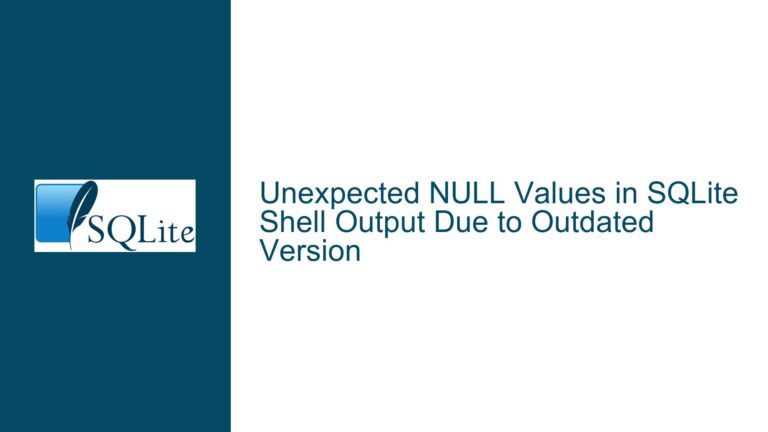Exporting SQLite Query Results to CSV Using SQL Scripts
Exporting Query Results to CSV in SQLite Without Built-in EXPORT Functionality
SQLite, unlike some other relational database management systems, does not provide a built-in SQL statement such as EXPORT or OUTPUT to directly export query results to a file. This limitation often confuses users who are accustomed to databases like MySQL or PostgreSQL, which offer more straightforward file export capabilities. However, SQLite provides alternative methods to achieve this functionality, primarily through its command-line interface (CLI) and shell redirection techniques. The core issue revolves around how to export the results of a complex query involving multiple table joins into a CSV file using an SQL script, without relying on manual intervention in the SQLite shell.
The challenge is compounded by the fact that SQLite’s SQL dialect does not natively support file operations or direct output redirection within SQL scripts. Instead, users must leverage the SQLite shell’s capabilities or external scripting to achieve the desired result. This post will explore the underlying reasons for this limitation, the possible causes of confusion, and detailed troubleshooting steps to export query results to a CSV file effectively.
Misconceptions About SQLite’s SQL Script Capabilities
One of the primary sources of confusion stems from the assumption that SQLite’s SQL scripts can perform operations beyond the scope of standard SQL, such as file I/O or direct output redirection. This misconception arises from comparing SQLite to other databases that offer extended SQL functionalities, such as MySQL’s INTO OUTFILE or PostgreSQL’s COPY commands. SQLite, being a lightweight and embedded database, intentionally avoids including such features to maintain its simplicity and portability.
Another contributing factor is the lack of clarity regarding the separation between SQLite’s core library and its CLI tool. The SQLite library itself is designed to be minimalistic, focusing solely on database operations without extending into file management or output formatting. The CLI tool, on the other hand, provides additional utilities like .mode, .headers, and .output to facilitate interaction with the database and format query results. Users often conflate these two components, leading to frustration when attempting to use CLI-specific commands within an SQL script.
Additionally, the absence of a scripting language or stored procedures in SQLite further limits the ability to automate tasks like exporting query results. While other databases allow users to write scripts that include both SQL and procedural logic, SQLite requires external tools or shell scripting to achieve similar functionality. This design choice is intentional, as SQLite prioritizes simplicity and efficiency over feature richness, but it can be a stumbling block for users unfamiliar with its architecture.
Leveraging SQLite CLI and Shell Redirection for CSV Export
To export query results to a CSV file using an SQL script, users must rely on the SQLite CLI and shell redirection techniques. The process involves configuring the CLI to format the output as CSV and redirecting the results to a file. Below is a detailed explanation of how to achieve this, along with practical examples and considerations.
Step 1: Preparing the SQL Script
The first step is to create an SQL script that includes the necessary CLI commands to configure the output format and the SQL query to generate the desired results. For example, consider the following SQL script, named export_query.sql:
.headers on
.mode csv
SELECT TABLE1.UI, TABLE2.AccountNo, TABLE1.Group
FROM (TABLE1
INNER JOIN TABLE2 ON TABLE1.UI = TABLE2.UI)
INNER JOIN TABLE3 ON TABLE2.UI = TABLE3.UI
WHERE TABLE3.Status = 'A';
In this script, .headers on ensures that the column names are included in the output, and .mode csv sets the output format to CSV. The subsequent SELECT statement performs the join operation and filters the results based on the condition TABLE3.Status = 'A'.
Step 2: Executing the Script Using the SQLite CLI
Once the SQL script is prepared, it can be executed using the SQLite CLI with shell redirection to capture the output in a CSV file. The following command demonstrates how to do this in a Unix-like shell (e.g., bash):
sqlite3 your_database.db < export_query.sql > output_file.csv
In this command, sqlite3 your_database.db invokes the SQLite CLI and opens the specified database file. The < export_query.sql part redirects the contents of the SQL script to the CLI as input, and > output_file.csv redirects the output of the query to a CSV file named output_file.csv.
Step 3: Verifying the Output
After executing the command, the output_file.csv should contain the results of the query in CSV format, with the column headers included. For example, the contents of output_file.csv might look like this:
UI,AccountNo,Group
12345,67890,GroupA
23456,78901,GroupB
34567,89012,GroupC
This approach effectively exports the query results to a CSV file without requiring manual intervention in the SQLite shell. It leverages the CLI’s capabilities to format and redirect output, making it a practical solution for automating the export process.
Step 4: Handling Large Datasets and Performance Considerations
When dealing with large datasets, it is important to consider the performance implications of exporting query results to a CSV file. SQLite’s lightweight nature makes it efficient for most use cases, but certain optimizations can further enhance performance.
One such optimization is to use transactions when executing the query. Wrapping the SELECT statement in a transaction can reduce the overhead associated with writing to the output file, especially when dealing with millions of rows. For example:
.headers on
.mode csv
BEGIN TRANSACTION;
SELECT TABLE1.UI, TABLE2.AccountNo, TABLE1.Group
FROM (TABLE1
INNER JOIN TABLE2 ON TABLE1.UI = TABLE2.UI)
INNER JOIN TABLE3 ON TABLE2.UI = TABLE3.UI
WHERE TABLE3.Status = 'A';
COMMIT;
Additionally, users should ensure that the database is properly indexed to speed up the query execution. In the example query, indexing the UI and Status columns in TABLE1, TABLE2, and TABLE3 can significantly improve performance.
Step 5: Automating the Export Process
For scenarios where the export process needs to be automated or integrated into a larger workflow, shell scripting can be used to encapsulate the entire process. For example, the following bash script automates the export process and includes error handling:
#!/bin/bash
DATABASE="your_database.db"
SCRIPT="export_query.sql"
OUTPUT="output_file.csv"
if ! sqlite3 "$DATABASE" < "$SCRIPT" > "$OUTPUT"; then
echo "Error: Failed to export query results to CSV."
exit 1
fi
echo "Query results successfully exported to $OUTPUT."
This script checks the exit status of the sqlite3 command and provides feedback on the success or failure of the export process. It can be scheduled using cron or integrated into a larger automation pipeline.
Step 6: Alternative Approaches for Non-CLI Environments
In environments where the SQLite CLI is not available or practical, alternative approaches can be used to export query results to a CSV file. One such approach is to use a programming language like Python with the sqlite3 module to execute the query and write the results to a CSV file. Below is an example using Python:
import sqlite3
import csv
DATABASE = "your_database.db"
QUERY = """
SELECT TABLE1.UI, TABLE2.AccountNo, TABLE1.Group
FROM (TABLE1
INNER JOIN TABLE2 ON TABLE1.UI = TABLE2.UI)
INNER JOIN TABLE3 ON TABLE2.UI = TABLE3.UI
WHERE TABLE3.Status = 'A';
"""
OUTPUT = "output_file.csv"
conn = sqlite3.connect(DATABASE)
cursor = conn.cursor()
cursor.execute(QUERY)
rows = cursor.fetchall()
with open(OUTPUT, "w", newline="") as csvfile:
writer = csv.writer(csvfile)
writer.writerow([description[0] for description in cursor.description]) # Write headers
writer.writerows(rows)
conn.close()
This script connects to the SQLite database, executes the query, and writes the results to a CSV file using Python’s csv module. It provides a flexible and portable solution for exporting query results without relying on the SQLite CLI.
Conclusion
Exporting query results to a CSV file in SQLite requires a clear understanding of the database’s limitations and the tools available to overcome them. While SQLite does not provide a built-in SQL statement for file export, its CLI and shell redirection capabilities offer a practical solution for most use cases. By preparing an SQL script with the necessary CLI commands and leveraging shell redirection, users can automate the export process and generate CSV files efficiently.
For environments where the CLI is not available, programming languages like Python provide an alternative approach to achieve the same result. Regardless of the method used, proper indexing and performance optimizations should be considered when dealing with large datasets to ensure a smooth and efficient export process.
By following the steps outlined in this guide, users can confidently export query results to CSV files in SQLite, even in the absence of built-in export functionality. This approach not only addresses the immediate challenge but also highlights the importance of understanding the tools and techniques available within SQLite’s ecosystem.






